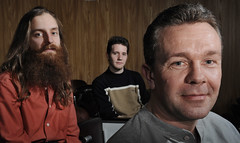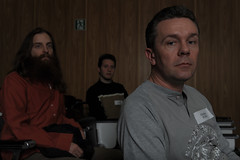 When I shot for newspapers, one of the most common visually subpar assignments was the two- or three-person group shot. Nothing against group shots per se, but the small group was usually indicative of a reporter who just couldn't say "no."
When I shot for newspapers, one of the most common visually subpar assignments was the two- or three-person group shot. Nothing against group shots per se, but the small group was usually indicative of a reporter who just couldn't say "no."The story might really be about Person "A," but the reporter gets strong-armed into this really being a "group effort," (translation: I don't want to be the only one in the photo, blah, blah, blah...)
So the 2-3 person group shot gets a bad rap from the get-go. Which is a shame, really, because most group shots are a good opportunity to play.
Why? Because you typically have nothing to lose since the normal group shot in the paper is a huge yawner to begin with. Hit the jump for a quick tip for carving out quick group light.
__________
Experimenting on Captive Subjects
Let me begin by saying that I especially love one thing about lighting classes: They are attended by a roomful of people who think it is perfectly normal to play around with light for no good reason whatsoever. So naturally, I use them as guinea pigs for lighting ideas that I have in the back of my head.
Lord knows, they are much more cooperative than my kids. Heck, the cat won't even stay in the same room with me at home any more.
I have a project coming up this summer that will call for shooting some edgy looking small group shots, so I want to work a look that has a little more cowbell than the typical big-soft-light group. Nothing wrong with that light -- just a little too been-there-done-that for me at this point.
 For the group above (R to L, Damian, Romain and Christian) at the CERN workshop, I started with my fill to place my baseline exposure before even considering the key lighting. The fill is an umbrella right behind the camera -- sort of a poor man's ring flash. A little better than ring, actually, as it is softer and does not leave that "ring signature" on the background wall.
For the group above (R to L, Damian, Romain and Christian) at the CERN workshop, I started with my fill to place my baseline exposure before even considering the key lighting. The fill is an umbrella right behind the camera -- sort of a poor man's ring flash. A little better than ring, actually, as it is softer and does not leave that "ring signature" on the background wall.I saw one immediate problem. The fill was not pushing to the back of the scene very well. This was because of the difference in distance between the fill as it hit the subject on the right (a coupla feet away from the camera) to the distance to the back wall (10-15 feet away). Of course the wall is gonna be dark, right?
 Solution: Back that flash up. This is where the on-axis umbrella kicks the ring's butt. With a ring flash, your light location relative to the camera is locked down. With the on-axis flash, not so much.
Solution: Back that flash up. This is where the on-axis umbrella kicks the ring's butt. With a ring flash, your light location relative to the camera is locked down. With the on-axis flash, not so much.So, by backing up the light we get better penetration of the fill into the back of the scene. Not perfect, but way better than before.
Now, it is just a matter of dialing in the baseline exposure before we accent the faces. This is a piece of cake, and easy to do by eye without a meter. Just light the scene with the umbrella fill, adjust the power until the scene looks good, and then alter either the flash power or the aperture until you see that the shadows -- areas will not be lit by your key(s) -- are where you want them to be. Check your histograms to make sure you are not falling off of the table on your darkest tones. Unless you really want to, of course.
 You can set the base fill by dropping your power on the umbrella. But you'd probably want to just close down your aperture in a case like this, to buy yourself some depth of field. I am not gonna carry Romain in the back as tack sharp, but I may as well get him recognizable.
You can set the base fill by dropping your power on the umbrella. But you'd probably want to just close down your aperture in a case like this, to buy yourself some depth of field. I am not gonna carry Romain in the back as tack sharp, but I may as well get him recognizable.Which brings up an important point. Just for the heck of it, we shot them exactly where they sat in class. Sort of an exercise in lighting angles. If I was shooting them critically, I would want to compress the distance to hold focus on all three.
 Now it is just a matter of adding the key lights. Remember, we are in total control of both the quality and the intensity of the fill, as we nailed that stuff down first. What that gives you is both the ability (and the excuse) to get a little atypical with your key lighting. We can go hard, grids, edgy angles -- whatever. Their faces will hold it because we have pre-determined the look and depth of the shadows.
Now it is just a matter of adding the key lights. Remember, we are in total control of both the quality and the intensity of the fill, as we nailed that stuff down first. What that gives you is both the ability (and the excuse) to get a little atypical with your key lighting. We can go hard, grids, edgy angles -- whatever. Their faces will hold it because we have pre-determined the look and depth of the shadows.For the key(s) we went with two hard speedlights, one of which sported a grid spot.
As the lead dog, Christian, right, got his own key light. It was gridded to control the beam spread. But I was able to light both Damian and Romain with the same speedlight, which was also bare.
You can more easily get away with hard lighting when you have pre-set your fill. Because while the transition from highlight to shadow will be quick and hard, you have decided exactly how far the drop-off will be. You can play it safe or be increasingly risky, by altering the intensity of your fill light.
You can see a setup shot here, courtesy Mark Howells-Mead of the Swiss Strobists Group. (Check out their meetup schedule if you are local, too.)
 Here it is again. I took some liberties with the seams on the back wall (which turned it into a pretty cool backdrop) and removed a sticker.
Here it is again. I took some liberties with the seams on the back wall (which turned it into a pretty cool backdrop) and removed a sticker. But what the hell, I am not bound to the newspaper's rules anymore. It's not a completely finished look. But this quick experiment give me enough to go on to where I feel comfy trying it for my project later this summer. I tried a second variation (still honing it) on a single portrait early this month. And I really like the way it is evolving. I will hit that one on a later post.
Test, Test, Test.
It sounds weenie, but it will give you the courage to try new stuff when you really need a different look. And when you get dealt your fourth three-person group shot in a week, a new look is exactly what the doctor ordered.
Không có nhận xét nào:
Đăng nhận xét